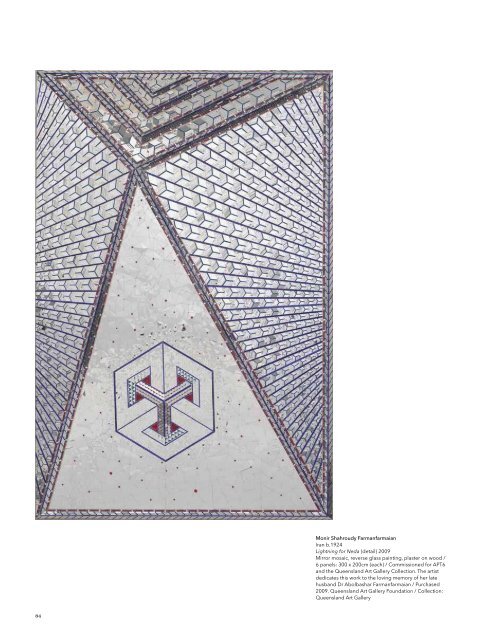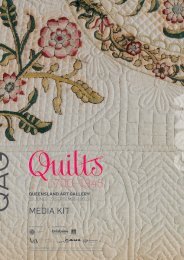Queensland Art Gallery - Queensland Government
Queensland Art Gallery - Queensland Government
Queensland Art Gallery - Queensland Government
Create successful ePaper yourself
Turn your PDF publications into a flip-book with our unique Google optimized e-Paper software.
Monir Shahroudy Farmanfarmaian<br />
Lightning for Neda<br />
Over a career spanning decades, Monir Shahroudy Farmanfarmaian has<br />
created an art imbued with the aesthetics of her Iranian culture. Inspired<br />
by its architecture and the traditions of Islamic geometry and pattern,<br />
and using media such as reverse-glass painting, mirror mosaic and relief<br />
sculpture, Farmanfarmaian has revived and adapted these forms to<br />
make original, compelling works. Clearly motivated to be an artist from<br />
her teens, she enrolled in Tehran University’s Fine <strong>Art</strong>s College in the<br />
early 1940s and then, at the age of 22, ventured to New York to study<br />
fashion illustration at Parsons School of Design. Following graduation,<br />
she pursued a career as a successful graphic and fashion designer and,<br />
during her 12 years in New York (1945–57), Farmanfarmaian became<br />
familiar with the city’s art scene — she met abstract expressionist Jackson<br />
Pollock and his wife Lee Krasner, and a young Andy Warhol. In 1957, she<br />
returned to Iran to develop her artistic career.<br />
In Tehran, Farmanfarmaian also directed her prodigious energy<br />
towards collecting. Assembled throughout the 1960s and 1970s, her<br />
collection reflected both her unconventional interests and informed<br />
and consolidated her aesthetic concerns. To this end, she gathered a<br />
group of highly coloured images prevalent in Tehran’s coffee houses 1<br />
and a significant group of tribal and antique reverse-glass paintings, as<br />
well as Turkoman tribal textiles and silver jewellery. 2 She also collected<br />
architectural fragments, such as doors, windows and wall panels. These<br />
latter pieces were salvaged from historic buildings (domestic as well<br />
as public) that were being demolished in her hometown of Qazvin,<br />
and in other cities in Iran, as part of the process of modernisation.<br />
Much of this was done to recover material culture that was rapidly<br />
disappearing, with the aim of gifting to Iranian state art collections.<br />
Immersing herself in this material and developing her own artistic<br />
language became interdependent activities for Farmanfarmaian,<br />
maturing into a unique practice.<br />
The characteristic mirror mosaic of Farmanfarmaian’s work is an<br />
Iranian decorative technique known as aineh-kari. As curator Rose<br />
Issa has explained:<br />
to structure and develop complex architectural ornamentation. Arab<br />
mathematicians of the ninth century added considerably to Greek and<br />
Indian scholarship, and Muslim craftspeople have long relied on this<br />
knowledge to produce the myriad patterns embellishing the facades<br />
and walls of buildings. In this work, the six sides of the hexagon<br />
provide an underlying structure, and are expanded and elaborated on<br />
as a repeated motif.<br />
The mystical and symbolic connotations assigned to numbers in<br />
Islamic culture are based on the profound symmetry that the grammar<br />
of mathematics offers, a great inspiration for Islamic scholars. In this<br />
way the point of origin is the dot; it also signifies the primordial, the<br />
one, the permanent, the eternal. The line connecting two dots is<br />
understood as a symbol of the polarity of existence, the first move<br />
or direction, and therefore the intellect. From here, the plethora of<br />
geometric shapes expands to include the circle, the triangle (the<br />
isosceles and the equilateral each offering different possibilities),<br />
and so on. The hexagon represents the six directions of motion (up,<br />
down, forwards, backwards, right, left), and the six virtues: generosity,<br />
self-discipline, patience, determination, insight and compassion. In<br />
each of the six panels constituting Lightning for Neda, Farmanfarmaian<br />
uses over 4000 mirror shards to activate a myriad of patterns across a<br />
glittering and sublime surface.<br />
Neda means ‘voice’ in Farsi and, in this work, the compelling voice of<br />
an octogenarian Iranian artist acknowledges the turmoil facing her<br />
country. Monir Shahroudy Farmanfarmaian has herself experienced<br />
the trauma of exile, leaving Tehran in the wake of the 1979 Iranian<br />
Revolution, and returning in 2003 to rebuild her life there. Although all<br />
her works and collections were confiscated in 1979, her strength as an<br />
artist could not be curbed. Thus, in the splendour of Farmanfarmaian’s<br />
vision, the majestic spirit of affirmation also lives.<br />
Suhanya Raffel<br />
Monir Shahroudy Farmanfarmaian<br />
Iran b.1924<br />
Lightning for Neda (detail) 2009<br />
Mirror mosaic, reverse glass painting, plaster on wood /<br />
6 panels: 300 x 200cm (each) / Commissioned for APT6<br />
and the <strong>Queensland</strong> <strong>Art</strong> <strong>Gallery</strong> Collection. The artist<br />
dedicates this work to the loving memory of her late<br />
husband Dr Abolbashar Farmanfarmaian / Purchased<br />
2009. <strong>Queensland</strong> <strong>Art</strong> <strong>Gallery</strong> Foundation / Collection:<br />
<strong>Queensland</strong> <strong>Art</strong> <strong>Gallery</strong><br />
The technique dates back to the 16th century, when mirrors were<br />
imported from Venice and Bohemia to Iran and arrived broken.<br />
The new owners had to find imaginative ways of recycling these<br />
shards of glass, and would set the pieces in stucco to create<br />
decorative panels with attractive multiple reflections. As well as Sufi<br />
symbolism of reflecting the self, mirror has since been associated<br />
with purity, brightness, symmetry, veracity and fortune. 3<br />
In Lightning for Neda 2009, Farmanfarmaian has constructed her most<br />
ambitious work to date. Commissioned for the <strong>Gallery</strong>’s Collection and<br />
premiering in APT6, its six panels of intricate mirror mosaic explore<br />
the geometric possibilities afforded by the hexagon. Essentially<br />
abstract, Lightning for Neda draws on the Islamic use of geometry<br />
Endnotes<br />
1 Coffee houses in Tehran are traditionally male-only establishments. Their walls are<br />
generally hung with stylised, highly coloured paintings of religious and national<br />
heroes. These works are identified as being made at the cusp of the Constitutional<br />
Revolution (1906–11).<br />
2 The Turkoman are a formerly nomadic tribal people from the region encompassing<br />
Turkmenistan, Afghanistan, northern Iraq and north-eastern Iran.<br />
3 Rose Issa, Mosaics of Mirrors: Monir Shahroudy Farmanfarmaian, Nazar Research<br />
and Cultural Institute, Tehran, 2006, pp.14–15.<br />
84 85
















